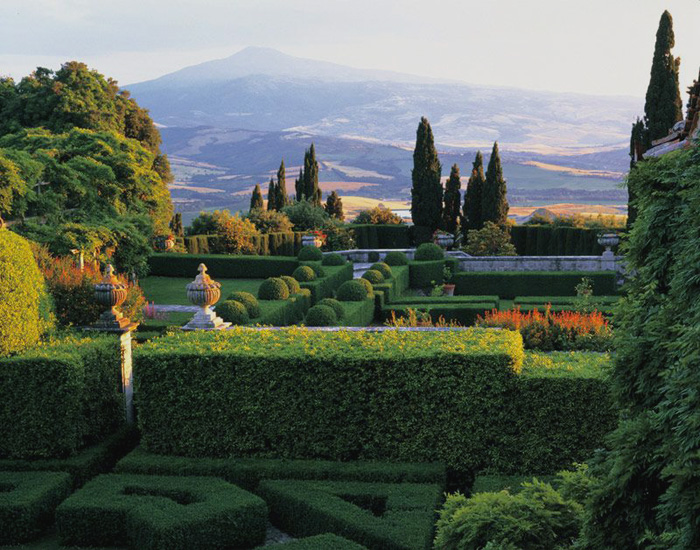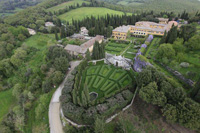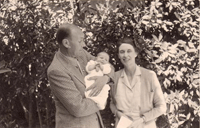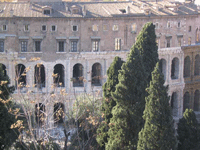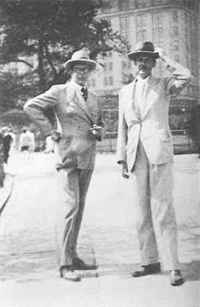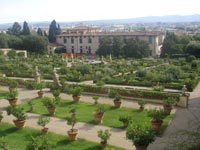|
|
| A view across the garden towards a horizon dominated by the volcanic peak of Monte Amiata “All that I can do is to foster within myself something that is not merely fear, resentment or bewilderment. Perhaps it might be useful to try to clear my mind by setting down, as truthfully and simply as I can, the tiny facet of the world’s events which I myself, in the months ahead, shall encounter at first hand.” Iris Origo |
|
Iris Origo |
Iris Margaret Origo, Marchesa of Val d'Orcia, DBE (15 August 1902 — 28 June 1988), was an Anglo-Irish biographer and writer. She lived in Italy, and devoted much of her life to the improvement of the Tuscan estate at La Foce, near Montepulciano, which she purchased with her husband in the 1920s.
Personal life |
| Villa Medici in Fiesole |
||
| The Villa Medici is a patrician villa in Fiesole, Tuscany, Italy, the fourth oldest of the villas built by the Medici family. It was built between 1451 and 1457. The villa owes its fame to Lorenzo il Magnifico who inherited the property in 1469 following the untimely death of his brother. The new master of the house turned the residence into a gathering place for artists, philosophers and men of letters such as Marsilio Ficino, Pico della Mirandola and Poliziano. The quadrangular building is a typical example of the 15th-century edifice, with square serena stone windows and broad loggias looking out over the surroundings. The villa remained the property of the Medici until 1671. It subsequently changed hands several times, and in 1772 was sold to Lady Orford, the sister-in-law of Horace Walpole. In the 19th century it was owned by the artist William Blundell Spence and in 1911 was purchased by Lady Sybil Cutting. Here Iris Origo spent fourteen years in an environment of exceptional privilege, comfort, and wealth. In 1918, Lady Sybil Cutting married the architectural historian Geoffrey Scott. Many friends of the family at Florence were other rich exiles, sophisticated and intellectual if somewhat rootless, and the author of this diary has confessed that she herself felt uncertain about who she was and where she belonged. Marriage to an Italian eventually made it possible to put down roots, and in 1924 the new couple bought a large estate in the heart of Tuscany, where her war-time diary War in Val D'Orcia: An Italian War Diary, and other books were written. Gardens in Tuscany | Villa Medici in Fiesole, Firenze |
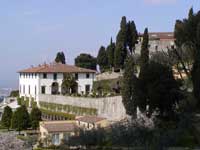 Villa Medici in Fiesole |
|
|
Enlarge map Villa Medici in Fiesole |
||
Villa La Foce |
||
| The estate of La Foce was located a hundred miles north of Rome, between Siena and Lake Trasimene. La Foce means 'the meeting point' as the fifteenth-century hostel was built at the intersection of the valley's two main roads. The Val d'Orcia had been much neglected over the centuries, laid bare by soil erosion and desolated by wars between rival city-states. The new owners set about restoring it to life. Fifteen years of hard work resulted in the establishment of fifty farms, each of about a hundred acres, all grouped round one central fattoria where the Origo family lived and where all the general decisions were made about what crops to grow and what agricultural methods to adopt. Each tenant farmer held his individual farm by the usual Tuscan system of mezzadria, sharing all produce with the proprietor but depending on him for equipment and capital.[4] There was no garden at La Foce when the Origos arrived, just the remains of a giardino Inglese which had probably been planted in the nineteenth century for ease of maintenance. In the early days water was scarce; the well barely provided enough drinking water and any excess went immediately to the farm. Soon after moving in, however, Origo began creating a small garden at the back of the villa, the furthest point from the busy fattoria courtyard. This was her private space, her bulwark against the vast, inhuman landscape. She later recalled how, on first vie\ving the property, she was overcome by a longing for gentle Florentine hills or green English fields - and most of all for a pretty house and garden to come home to. It was this that Pinsent helped her create.[4] Through the wood, a path joins the garden and the family cemetery, considered one of Pinsent’s best creations. |
||
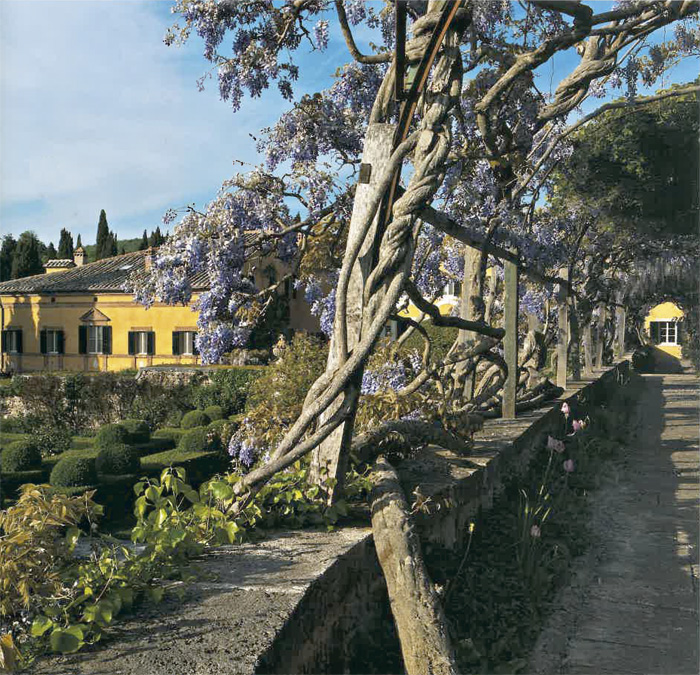 |
||
Villa La Foce, Pergola covered with roses and wisteria |
||
| While the Origos were on their honeymoon Cecil Pinsent was employed to install some basic comforts, adding a skylight to illuminate the central room, incorporating fireplaces, a bathroom, a library and sitting room. Once the villa was habitable Pinsent moved on to oversee the restoration and expansion of the rest of the estate. As a lifelong bachelor he was easily absorbed into the family and after his friend and partner, Geoffrey Scott, married Lady Cutting, Pinsent would join the Origos at the Villa Medici for the family Christmas. In the early years of the Origos' marriage he travelled with them on several occasions and would reside at the villa for months at a time while engaged in design projects. 'The Origos briskly, pragmatically, set about restoring the infrastructure of the entire estate. They implemented progressive social ideals as well as far-seeing farming methods which employed innovative agricultural practices. The estate’s farm-houses, eventually more than 50 in all, were renovated and/or completely rebuilt; the main villa was refurbished; and a school and dispensary were created, the latter named after Gianni, the Origo’s first-born, who had died of meningitis at the ageof seven.' |
||
|
Enlarge map of Villa La Foce |
||
| In creating La Foce, Origo worked with Cecil Pinsent, her childhood friend, reprising the classic gender partnership in which he provided the architectural structure which she then clothed in colour, scent and texture. Origo was an unusual woman; she lived through extraordinary times and responded with immense imagination, courage and compassion. Born in 1902 the only child of Bayard and Sybil Cutting, Origo had a cosmopolitan childhood traveling between her American grandparents in Long Island, her British grandparent:~ in Kilkenny, the London home where her father acted as secretary to the American ambassador and long stretches at the Villa Medici. Since her father's dying wish was that his daughter should be educated at home, Origo spent a lonely childhood in the company of her mother's intellectual Anglo-Florentine friends. When Pinsent came to design the garden at Villa Medici, despite the eighteen year age gap, he proved a godsend to the solitary child. On his death in 1963 Origo wrote to his family: 'he was, I think, my oldest friend; all the memories of childhood are mingled with him.' At the time that Aldous Huxley was writing Those Barren Leaves, Origo was already rebelling against the insular community which he so viciously lampooned in his roman-a-clef Ultimately she chose 'a more authentic Italian existence than any of her compatriots when, in 1924, she married a handsome, illegitimate, Catholic aristocrat, the Marchese Antonio Origo. In a situation worthy of a Henry James novel, he was impoverished, worldly and ten years older than the innocent heiress. Needless to say, her family attempted to stop the union. Bernard Berenson trekked down the hill from I Tatti to advise her to keep her American citizenship, while Mary Berenson confided to her diary: 'there is a sort of feeling abroad that she cannot be long happy with that anti-intellectual young man'. Having failed to prevent the marriage, Lady Cutting retreated to her sick bed and was absent from the wedding. As predicted, the union was often strained, not least by his infidelities, her infidelities, the death, in childhood, of their beloved son and the political situation which left them with differing allegiances in the Second World War. Nonetheless the marriage survived and within it the Origos lived creative and productive lives. Spurred, perhaps, by the example of her indolent, hypochondriacal mother, the newly married Origo determined to do something useful. She envisioned social work, her husband had the instinctive Italian love of the land; they both wanted to leave the city, so, infused with Virgilian fantasies, they settled on a career in farming. Privately, Origo hoped for an austere villa with a long cypress-lined approach, a deep loggia, a courtyard, a well and a fountain garden surrounded by overgrown box hedges. Her husband wanted something more challenging. On discovering that most of the available properties around Florence were already 'neat and fruitful', having been cultivated since the days of the Decameron, the Origos looked further afield.
|
||
| In the Val d'Orcia, a depopulated area in southern Tuscany, the Origo's found the 3,500 acre estate of La Foce. A forlorn desert of barren clay hills rising from a parched valley, the estate had been mismanaged for centuries; only a fraction of the land was good, only a fraction of that was cultivated, the forests were neglected and the twenty-five outlying farms were in varying states of disrepair - some were virtually inaccessible while most contained several dozen inhabitants crammed into a few dark, airless rooms. To the south stood the black, basalt cliffs and towering fortress of Radicofani, to the west was the summit of Monte Amiata, an extinct volcano which blocked the sea breezes but did nothing to stop the bitter tramontana wind from the north and the hot dry scirocco from the south. Despite this unpromising prospect, the Origos were enchanted: To live in the shadow of that mysterious mountain, to arrest the erosion of those steep ridges, to turn this bare clay into wheat-fields, to rebuild these farms and see prosperity return to their inhabitants, to restore the greenness of these mutilated woods - that, we were sure, was the life that we wanted. The period of June 1943 – June 1944 was historically catastrophic for Italy: prolonged vacillation over declaring neutrality, or siding with the Allies, created a political vacuum in which civil war erupted. The printed portion of Iris’s diary covers this bleak phase and records her microcosm, caught in the crossfire of conflicting battles and a confusion of combatants. Both the steeply rocky, chestnut-covered slopes of Monte Amiata and the overgown woods of the Val d’Orcia were replete with soldiers and refugees of diverse nationalities, as well as a strong partisan movement; the inhospitality and wildness of the terrain rendered it an excellent hiding place. There was no shortage of wounded and starving to attend to and the Origos, along with surrounding peasant farmers, showed a deeply humane disregard for political persuasion; they did whatever they could in response to all pleas, often dire, for help. The numbers of children on the estate also swelled with an influx of children given refuge from the heavy bombing in Turin and Genoa.[7] |
||
 |
||
Refugee children from Genoa and Turin |
||
| The Origos briskly, pragmatically, set about restoring the infrastructure of the entire estate. They implemented progressive social ideals as well as far-seeing farming methods which employed innovative agricultural practices. The estate’s farm-houses, eventually more than 50 in all, were renovated and/or completely rebuilt; the main villa was refurbished; and a school and dispensary were created, the latter named after Gianni, the Origo’s first-born, who had died of meningitis at the age of seven.[7] |
||
| After expanding La Foce's fattoria and making the house habitable, Pinsent was asked to redesign the formal approach to the villa. The public road, which had passed right beside the villa's front façade, was diverted to create an elegant fore court_ This was screened from the new road with an imposing wrought-iron gate, whose double piers framed the front loggia. Origo promptly planted the short approach avenue with cypresses to give an imprimatur of age. [4] In 1933 Pinsent added the chapel and cemetery which he considered one of his finest works. Situated in woodland at some distance from the house, the cemetery was enclosed by cypresses and walls, against which grew pittosporurn, and it was planted by the Marchesa with blue periwinkle and roses amongst the graves so that it formed a garden, a thing unknown in Italy at that time. |
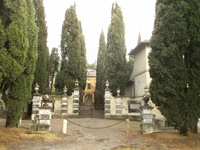 |
|
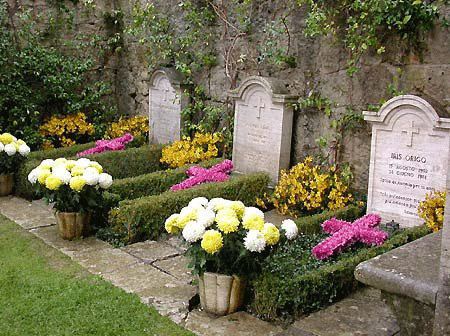 |
Villa La Foce, cemetery, where Iris Origo and her husband are buried, alongside Gianni. | |
Rome |
||
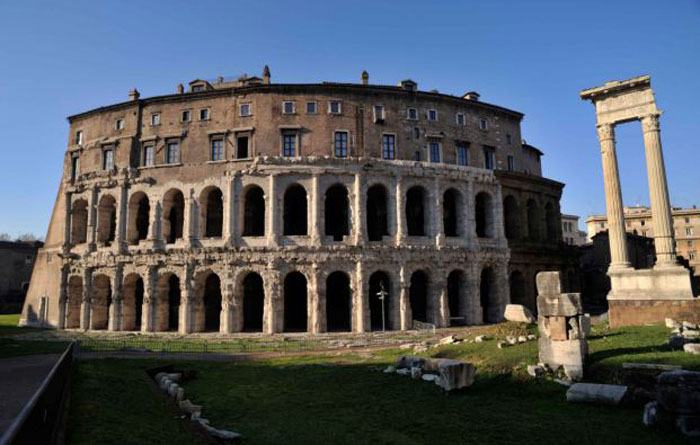 |
||
The Palazzo Orsini is grafted on top of the first-century Theatre of Marcellus |
||
| Palazzo Orsini, which Iris Origo rented and then bought in the 1950s, is situated in the centre of Rome. The palazzo, with a garden full of fountains and orange trees, is built on top of the still-standing stone and marble shell of the Theatre of Marcellus, dating from the 1st Century BC, which resembles a mini Colosseum. Construction of the Theatre of Marcellus, which could seat 20,000 people, was begun by Julius Caesar but it was completed in 11BC by the emperor Augustus, who named it after his favourite nephew. It was abandoned in the 4th century AD but later turned into a fortress and, later, into a family palazzo, constructed on the massive travertine blocks that make up the Roman theatre, known in Italian as the Teatro di Marcello. It passed into the hands of the Orsini family, after which it is named, in the 18th century. In 2012 Palazzo Orsini was for sale for 26 million euro, roughly $39 million dollars.. The 11,000 square foot house/apartment grafted on top of an ancient Colosseum. Palazzo Orsiniwas the most expensive house for sale in Rome, and one of the most expensive in Europe.[6] |
||
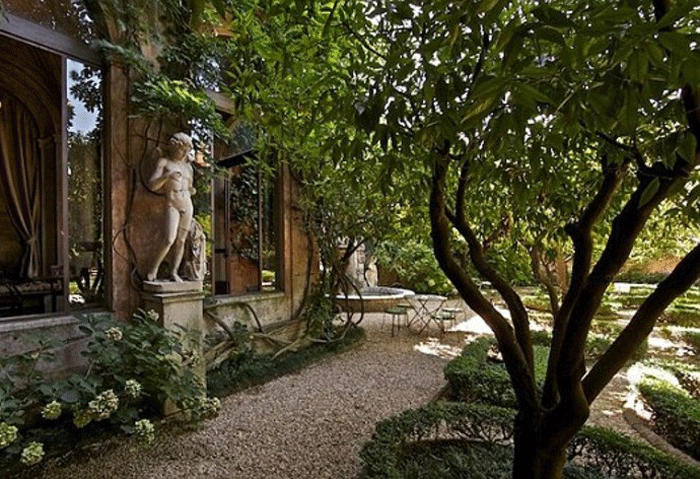 |
||
A shaded area of the palace's gardens |
||
|
||
| The Origos also spent holidays at Gli Scafari, the house built by Iris’s mother at Lerici, on the Gulf of Spezia. Antonio Origo died on 27 June 1976, and Iris Origo herself died on 28 June 1988. |
||
Allegra (1935), a short life of Byron’s daughter |
||||
| [3] At the end of the nineteenth century, the hills around Florence were filled with abandoned villas whose aristocratic owners had gone bankrupt, lost interest, or moved on to Rome when it became the capital of the newly unified Italy. In his 1909 book, Italian Hours, Henry James observed, ‘if one is an aching alien half the talk is of villas'; he also noted that for less than the price of a good painting one could purchase an entire villa, garden and surrounding estate. Outcasts, exiles and adventurers of all nationalities rushed to do this, but it was the English and Americans who focussed on the gardens, and the Americans who had the money to do so in style. To speak of these gardens as American, however, is misleading. These gardens are infused with an English sensibility and an Edwardian love of formality, though perhaps an American sense of scale and a Puritan suspicion of ornament can be detected in their simple, monumental lines. Iris Origo was the daughter of William Bayard Cutting, the diplomat eldest son of a rich and philanthropic New York family and Lady Sybil Cuffe, the daughter of Lord Desart, an Irish peer. Her parents travelled widely after their marriage, particularly in Italy, when her father contracted tuberculosis. Following her father's death in 1910, Iris and her mother settled in Italy, buying the Villa Medici in Fiesole, one of Florence's most spectacular villas. There they formed a close friendship with Bernard Berenson, who lived not far away at I Tatti. IIn 1918, Lady Sybil Cutting married the architectural historian Geoffrey Scott, who later embarked on a relationship with Vita Sackville-West, , and Pinsent was hired to work on the garden of Villa Medici. The marriage was to last until 1926. Gardens in Tuscany | Villa Medici in Fiesole, Firenze American gardens in Florence. Exploring La Pietra, I Tatti, Le Balze | www.theflorentine.net [3a] Percy Lubbock was the son of the merchant banker Frederic Lubbock (1844–1927) and his wife Catherine (1848–1934), daughter of John Gurney (1809–1856) of Earlham Hall, Norfolk, a member of the influential Norwich banking family. Earlham, his memoir of childhood summer holidays spent at his maternal grandfather's home was to win him the James Tait Black Memorial Prize in 1922. He was brought up at Emmetts near Ide Hill in Kent. He lived at Gli Scafari, a villa on the Gulf of Spezia designed by Cecil Pinsent. Towards the end of his life he went blind. Well-placed socially, his intellectual connections included his Cambridge contemporary E. M. Forster, Edith Wharton ( he was a member of her Inner Circle from about 1906), Howard Sturgis and Bernard Berenson. Other Cambridge friends included the singer Clive Carey. In 1926 he married Sybil Scott, née Lady Sybil Marjorie Cuffe, making him stepfather to the writer Iris Origo. Sybil was daughter of the Irish peer Hamilton John Agmondesham Cuffe, 5th Earl of Desart, and a widow after the 1910 early death of her first husband William Bayard Cutting, from tuberculosis. Her second husband had been Geoffrey Scott, another of the Berenson circle. Lubbock's terminal coldness with Edith Wharton, from 1933, was occasioned by some unexplained factor concerning this marriage. He was a good friend of Henry James in James's later life, and became a follower in literary terms, and his editor after his death. Later scholars have questioned editorial decisions he made in publishing the James letters in 1920, at a time when many of those concerned were still alive. Mark Schorer, in his introduction to a reprint of Lubbock's The Craft of Fiction, described him as "more Jamesian than James". The couple lived together in Gli Scafari, on the Gulf of La Spezia, until they moved to Switzerland to escape World War II, where Lady Sybil died on December 26, 1943. [4] Katie Campbell , A modern pastoral in an ancient landscape - Iris Origo's La Foce, in Paradise of Exiles: The Anglo-American Gardens of Florence, p. 159-161 [5] American gardens in Florence. Exploring La Pietra, I Tatti, Le Balze | www.theflorentine.net |
|
|||
[6] The history of the Palazzo Orsini can be traced back more than 2,000 years. Coming Home to Heroism, The Spectator 7 October 2000. Available online. Book review of Caroline Moorehead's Iris Origo: Marchesa of Val d'Orcia (London, John Murray, 2000) |
||||
This article incorporates material from the Wikipedia articles Iris Origo, Caroline Moorehead, Percy Lubbock, published under the GNU Free Documentation License. |
||||
|
This formal cloister offers the quiet tranquility of a private retreat, with numerous attractions, beautiful nature reserves and unspoilt beautiful beaches within easy reach. The most interesting artistic, historical and cultural sites of southern Tuscany are nearby, and are awaiting your discovery. Explore the medieval hillside villages on your way to Siena, marvel at settlements that date back to Renaissance times, try some Pecorino cheese in Pienza, and some wine in Montalcino or Montepulciano, where the refined beauty of the squares and churches blends perfectly with the ancient traditions of its wines. |
||||
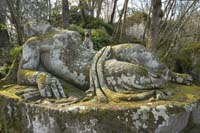 |
||||
Podere Santa Pia |
Podere Santa Pia, view from the garden on the valley below |
Il parco dei Mostri di Bomarzo |
||
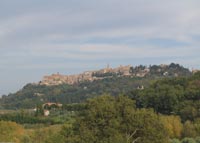 |
||||
Montepulciano |
Pienza |
Parco di Villa Reale di Castello (Villa di Castello) in Florence |
||
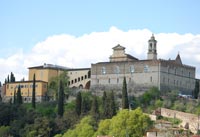 |
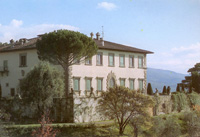 |
 |
||
Certosa del Galluzzo (Firenze) |
Villa Gamberaia at Settignano |
Boboli gardens in Florence |
||
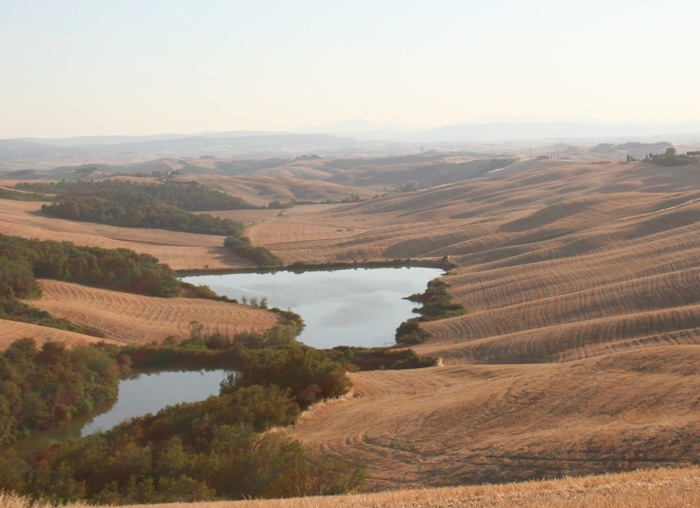 |
||||
The surroundings of Podere Santa Pia, the Val d'Orcia |
||||
|
||||
|
||||

